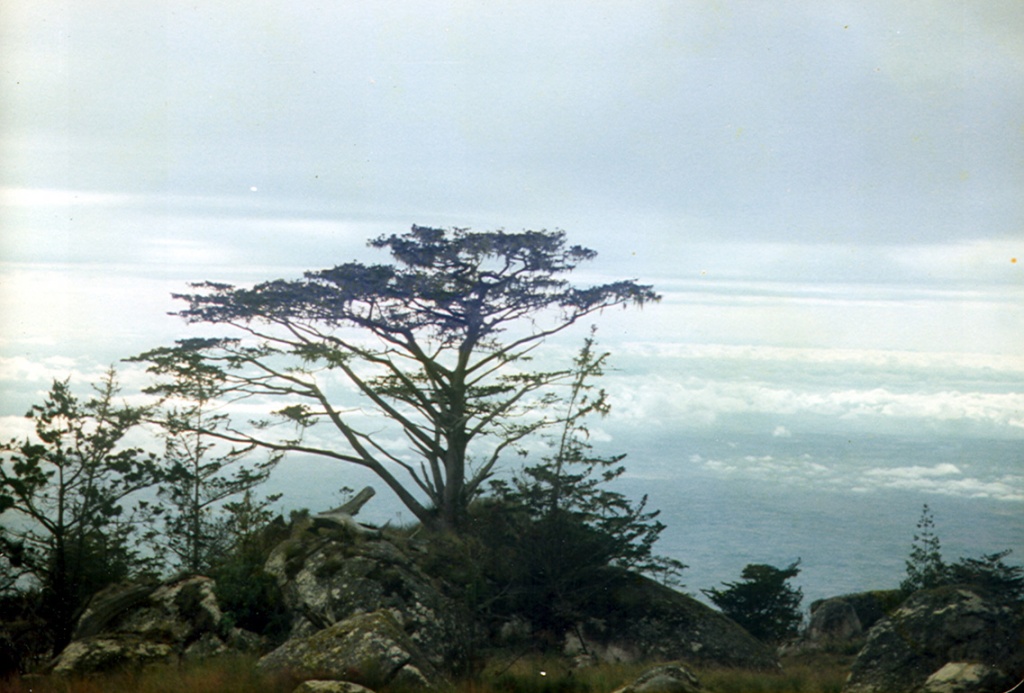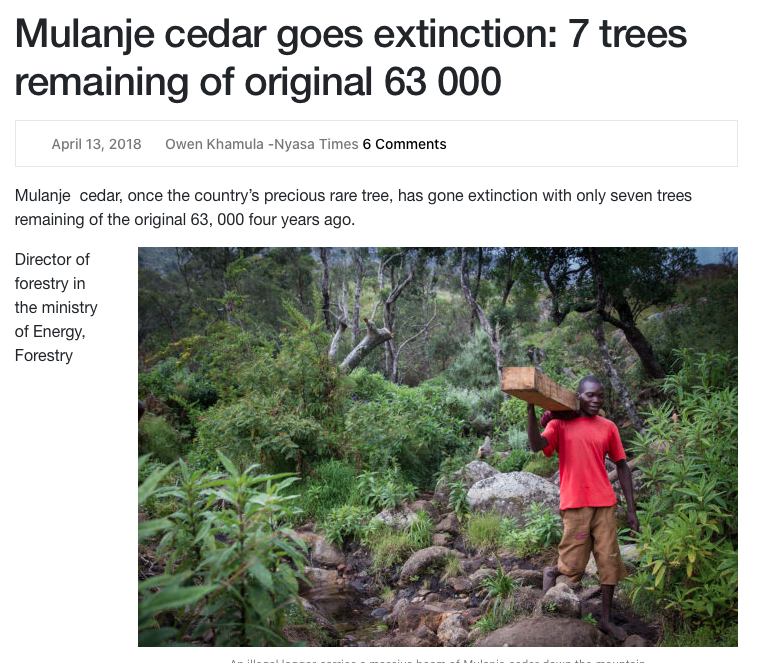
Some 40 or more years ago, when I first read Venture to the Interior by Laurens van der Post, I was struck by his vivid description of a dense forest of unique cedar trees, high on the Mulanje Plateau in southern Nyasaland, (now Malawi). Having spent much of my childhood on the edge of a soft and bright ancient beech wood in the Chilterns, the dark, ominous forest that van der Post describes evoked a very different experience of trees and woodland to my own. I’ve wanted to write about this ever since. But I hadn’t bargained for what I would discover (Spoiler alert: scroll down to the end of this blog article).
Venture to the Interior is a narrative account of Van der Post’s mission to Nyasaland (now Malawi) in 1949 to explore two relatively unknown parts of the country for the British government.
The book is, despite its intrinsic colonial tone, beautifully written. Van der Post was something of an evangelist for the theories of Carl Jung, the Swiss psychoanalyst, so it is little surprise that Venture to the Interior treats Africa, the continent in which he was born, as a metaphor for the unconscious – and more specifically his own unconscious – which he contrasts with ‘rational’ Europe, his adopted home as an adult. There is, he says in the Preface to the book, “…an unresolved conflict between two fundamental elements in my make-up; conscious and unconscious, male and female, masculine and feminine; the constitution of my father and the presence of my mother in me. On one side, under the heading “AFRICA”, I would group unconscious, female, feminine, mother; and under “EUROPE”: conscious, male masculine, father.” (pp.12-13). Comparisons with Joseph Conrad’s Heart of Darkness, written 60 years earlier, are obvious.
Here are extracts from the pages dealing with van der Post’s first encounter with the cedars of Mulanje, in his ascent with Peter Quillan, the Chief Forestry Officer of the province and their meeting with forester, “Dicky” Vance, whom they arrange to meet near his forestry hut:
It seemed that Mlanje, from the forestry point of view, was unique. There was no other place like it in Africa or the world. It was indeed a world of its own, a very ancient, lost world of trees that grew nowhere else. These trees, he [Quillan] said had been given the name of cedars, Mlanje cedars, because they looked to the uninitiated eyes like cedar. But they were not cedars at all. They were a conifer of a unique and very ancient sort, had their roots in the most antique of antique Africa botanical worlds.[1] I would see them for myself soon, in fact I would smell them even before I saw them. Their scent, night and day, filled the air on the mountain; filled it with a heavy, all-pervasive but delicious scent of a lost world; of a time and a place that existed nowhere else.
Their colour, like their scent, was unique. It was green, of course, but like no other green; there was a sheen of the olive green of cypress, and the substance of the green of the ilexes of Greece and the Caucasus; the texture of the conifers of Columbia and the vital electric sparkle of African juniper. In the bark, in the veins and arteries of those trees, the sap, a thick, yellow, resinous sap of a specific gravity and density most unusual in conifers, ran strongly. If you laid your ear to a trunk, it was almost as if you could hear this vital, this dark, secret traffic drumming upwards, skywards, from the deep, ancient soil, the original earth perhaps of Africa, to the outermost, the smallest spike of a leaf, sparkling in the sun a hundred, even a hundred and twenty feet above. So full were the trees of this vital sap that it preserved them even in death; no insect, no worm, no ant would touch even the driest morsel of .it. It was the only ant-resisting wood in the whole of Africa.
But when one threw it on the fire as I would soon see, it was so full of life, of stored-up energy from another world, that it literally exploded into flame. It consumed itself joyfully and gaily, crackling explosively in flame with none of that lugubrious reluctance to burn of some other woods that Quillan could mention. And fire, unfortunately had nearly been the cedars’ undoing. Some centuries ago when human beings first appeared in the plains round Mlanje, great fires swept up the mountain and burnt havoc through the responsive cedar woods. They, the Forestry Services, had come just in time to save the remnants of it.
There was still a good deal of forest left–enough for them to exploit in order to get the money to rejuvinate [sic] the species, but what I would see was a world of cedars in retreat, a world of unique and irreplaceable living trees, fighting a desperate rearguard action against fire and rapacious human beings, standing-to gallantly, night and day, without cease in the deepest, dampest and remotest recesses of the mountain. Surely I could understand why they were so jealous, so suspicious on the trees’ behalf! [..]
[Quillan] explained that they were so short of good wood in Nyasaland that they were cutting cedar at Chambe, sawing it up by hand and carrying it down the mountain, each length separately on the head of black porters.
“It is hell for them” said Quillan “but they don’t mind and we have got to do it. We make it up to them by feeding them and paying them as well as we can, but we don t like it.[…]
I became aware of a strange, thick, resinous, spiced, oily scent, and Quillan said: “Do you mind getting off the track, please?”
There seemed to be a deep, sheer drop on our right, so, using saplings, we pulled ourselves up on to a steep slope to the left of the track. I heard the pad-pad of heavily burdened feet coming out of the mist above, then someone breathing and puffing with every cell of his lungs, followed by a smell of human sweat mingling with the scent of resin and a native balancing a heavy, thirty-foot beam of cedar on his head, came out of the mist towards us.
I thought it wrong, somehow, that laden and breathing as he was, he should feel compelled to raise his hand and say, “Morning, Bwana !” Besides, he was just on the edge of a precipice.
“He gets ninepence a day and some food for doing that,” said Quillan. “I’d be damned if I’d do it.”
From now on we passed dozens of carriers coming down the mountain at regular intervals. Quillan always took the same punctilious care to make way for them. We began to talk less. The track became steeper and we had to use our hands as well as our feet in places. One bit of it passed a tremendous drop of smooth sheet rock, cyanite I think Quillan called it. The rock had a seventy-degree slope above us, but below it dropped sheer into the mist. We clambered across it from one precarious foothold of moss and aloe root to another.[…]
At twelve exactly, three hours after our start, as we were going up a particularly steep part of the mountain using our hands as well as our feet in places, I heard dogs barking in the mist above us.
“Those are Vance’s dogs. I expect he is coming to meet you,” Quillan said, paused, and sniffing at the mist, added: “Do you notice something?”
It was that heavy scent. Every time the timber carriers went by I had smelt it, a scent that I had not come across anywhere else. But now it was much more confident and pronounced. I nodded.
“Cedars,” he said, breathing the scent in with deep satisfaction. “Cedars, as I told you. We are near the top now.” […]
The peaks were still covered but the valley, the so-called Chambe plateau up which we had walked, became more and more open to view. I could see what Arbuthnot meant by saying it was like a glen in Scotland. It was utterly unlike the Africa we had left down below.
It was covered in lovely long rye, oat and barley grasses, gold-green and purple in their early winter colours. Through the valley on all sides, from behind folds, hills, and many slow, gradual rises in its contours, flowed crystal-clear streams, presumably the rainbow trout streams of which I had heard so much.
At first I thought there were palm trees growing on the banks of the streams, but I soon realized that they were huge tree ferns, the last remnants of the great cedar forests that once had covered this valley too. The scent of the cedars themselves now was most marked. Soon I began to see them, as Quillan had so vividly described them to me: at first, in small clusters driven back into odd, remote nooks of the valley, but then, as we went deeper into the valley, there appeared in the central gash of it a real, dank, brooding, resentful forest of them. It was rather an awe-inspiring sight. They looked, in an odd way, prehistoric; lovely, but long before human time. I would not have been surprised to see a pterodactyl fly out of them. All round the edges their branches were festooned and heavily hung with garlands and veils of lichen and moss.
“Aren’t they wonderful!” Vance said to me in his clear, firm voice, proudly as if he had invented them. […]
[Vance’s forestry hut] stood on a high grass-gold mound in the central gash of the valley. There was a wide clear stream and a darker fringe of immense cedars round the bottom of the mound. As we made our way slowly towards it the afternoon light turned it purple and it looked rather like some kind of unadorned velvet set in a crown of be-metalled cedars. On either side of the stream there were long slopes of golden grass, speeding away and up to where three miles farther on perpendiculars of solid grey cliffs, smooth and shining like the bark of a blue-gum tree., rose two to three thousand feet above the floor of the valley. All around the cliff-tops the mist continued to sag heavily.
The hut itself was built of crossed-cedar beams, lath and plaster. It had a roof of cedar shingles, a little cedar veranda at the back, cedar floor-boards and, I was to find, a few pieces of crude cedar furniture as well. It burned cedar logs whose flame and. smoke added to the cold air their own variants of the generic all-pervasive scent. The smoke rose straight up for some hundreds of feet, wavered, and then curved slowly back on its course, until it looked like a feathery question mark stuck into the roof of the hut. […]
“I hope you won’t mind, but look, you are not going to take all this away from us are you?” [said Vance].
“How could I? And why should I?” I said.
“I don’t know,” he said miserably. “I don’t know, but the feeling seems to be that you might want to use Mlanje for something other than forestry?”
I reassured him as best I could. I said I had not seen Mlanje, had no preconceived notions about it, but judging only from what I had seen that day, it seemed obvious that whatever happened very special provisions would have to be made for the cedars and their rejuvenation. But it seemed to be a tremendous mountain and there might be room for other things besides cedars.
“It is big enough,” he said sadly. “It’s big enough! That’s the trouble. Butyou know, anything else, particularly sheep or cows, wold spoil it. They wouldn’t belong, It should all be recovered with cedars from end to end, as it once was.” […]
“I am sure it will be all right,” [I said]. “We’ll see that your cedars are all right anyway.”
Extracts from Laurens van der Post, Venture to the Interior. Chatto and Windus, London, 1952. (Queen’s Classics edition 1962). 116-127.
It seemed that Mlanje, from the forestry point o view, was unique. There was no other place like it in Africa or the world. It was indeed a world of its own, a very ancient, lost world of trees that grew nowhere else. These trees, he [Quillan] said had been given the name of cedars, Mlanje cedars, because they looked to the uninitiated eyes like cedar. But they were not cedars at all. They were a conifer of a unique and very ancient sort, had their roots in the most antique of antique Africa botanical worlds.[1 I would see them for myself soon, in fact I would smell them even before I saw them. Their scent, night and day, filled the air on the mountain; filled it with a heavy, all-pervasive but delicious scent of a lost world; of a time and a place that existed
[1] The Mulanje cedar is Widdringtonia whytei, an evergreen conifer, native to Malawi (former Nyasaland) and found only on the Mulanje Massif altitudes of 1,830-2,550 metres. It has been renamed the “Mulanje cypress” to better reflect the taxonomic group it belongs to. It is a fast-growing, pioneer species and will usually grow back quickly after fire. However, its durability and resistance to insects and fungi made it in great demand for most of the 20th century for construction, driving it to the point of extinction.


For an update and photos, see also this Guardian article by Morgan Trimble (Tue 22 Sep 2015 12.08 BST)
and this piece by Wiliam Atkinson from Sun 15 Jan 2012 00.04 GMT
